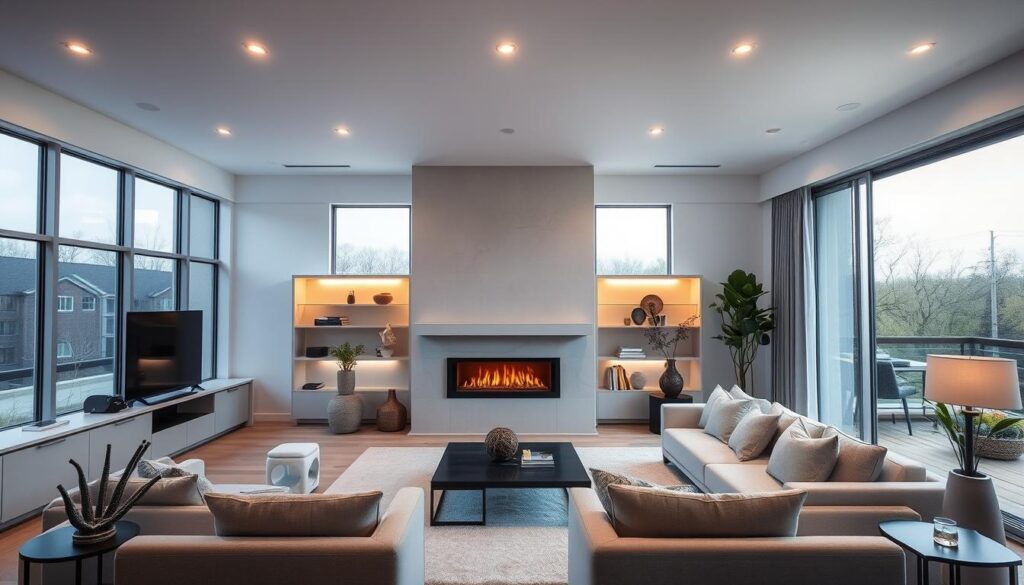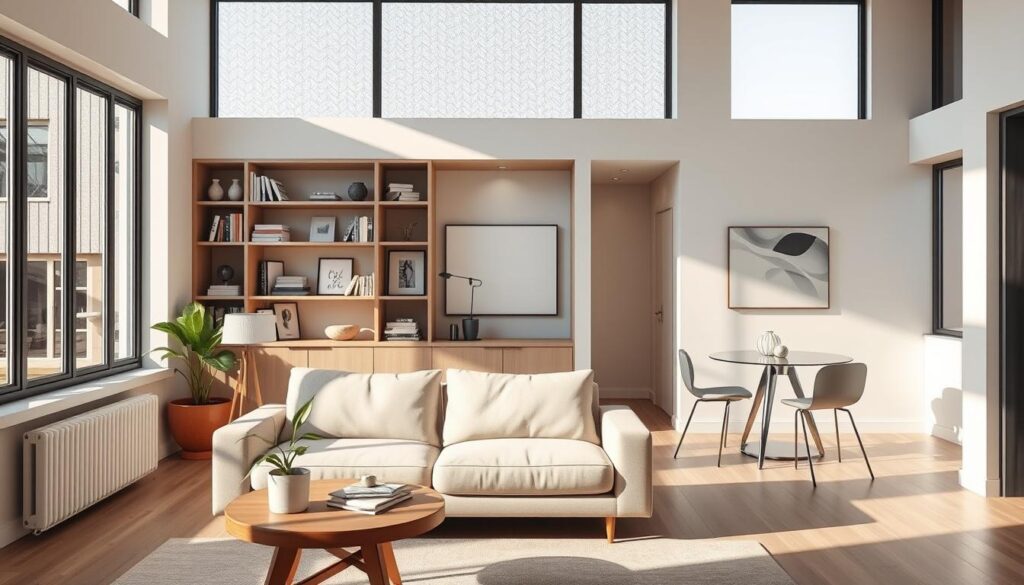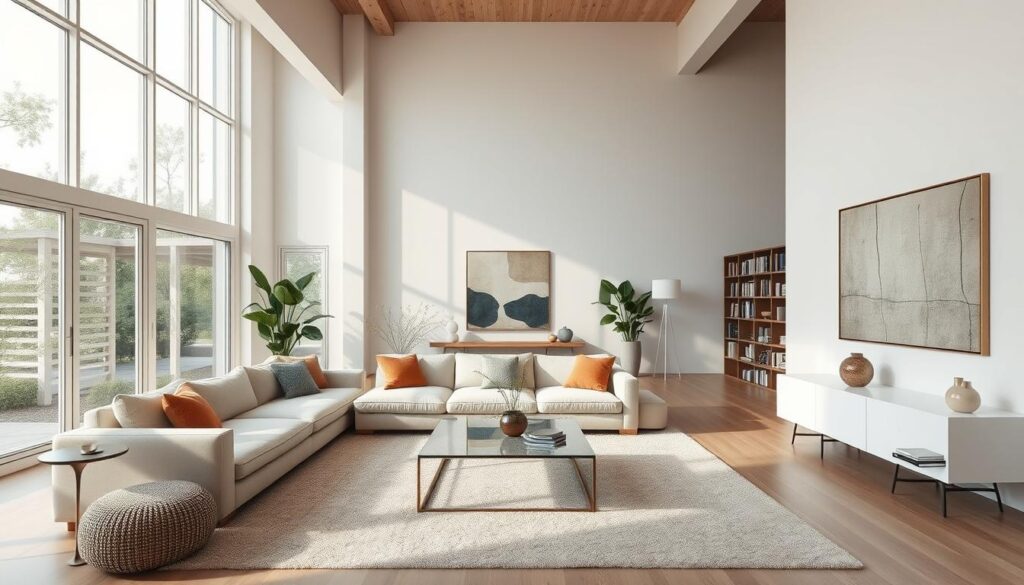Did you know a well-designed home’s interior can boost its value by up to 10%? A balanced mix of elements can turn your space into a stylish retreat. We’ll show you the key principles of interior design to make it happen.
Improving your home’s interior is more than picking the right furniture. It’s about creating a unified look that shows off your style. By mixing different elements, you can make a space that looks great and works well.
Key Takeaways
- Understand the core principles of interior design
- Learn how to create a harmonious balance in your home
- Discover how to blend different elements for a cohesive look
- Transform your space into a stylish oasis
- Increase your home’s value with effective design
Understanding Our Style Preferences
To make your home look better, first figure out what makes your style unique. This means looking into your personal taste and how to mix different designs for a unified look.
Identifying Personal Aesthetics
Your personal style is the base of your home’s design. It’s about knowing if you like modern interiors with simple designs or traditional styles with rich textures and classic furniture.
To find your personal style, think about:
- The colors you like
- The furniture that feels right to you
- The artwork and decor that speaks to you
Reflecting on these points helps you understand what your style in home decor is.
Blending Different Design Elements
After knowing your style, learn to mix different design parts. This might mean combining modern furniture with traditional decor, or mixing textures and patterns for depth.
The secret to mixing elements well is finding something that connects them. This could be a common color, texture, or style. For example, you could mix modern interiors with traditional wooden furniture for a cozy and unique space.
Here are some tips for mixing designs:
- Begin with a neutral base to add color and texture with furniture and decor.
- Try out different patterns and textures, but keep it balanced to avoid too much.
- Feel free to mix high and low pieces for a look that’s both curated and personal.
By knowing your style and how to mix designs, you can make a home that looks amazing and truly reflects you.
Essential Design Principles
Essential design principles are key to contemporary living spaces. They help us create homes that look good and work well.
Balance and Harmony
Balance and harmony are vital in interior design. They make a room feel stable and comfy. We can use symmetry, asymmetry, or object weight to achieve this.
For example, Scandinavian design uses simple decor and natural materials. This adds to a room’s harmony.
Color Theory Basics
Color theory is crucial for a welcoming atmosphere. Colors affect our mood and how we see a space. We can use the color wheel to pick matching colors.
Complementary colors create a bold contrast, while analogous colors are soothing. These principles make our contemporary living spaces better.
| Color Scheme | Description | Effect |
|---|---|---|
| Monochromatic | Using different shades of the same color | Creates a cohesive look |
| Complementary | Pairing colors opposite each other on the color wheel | Produces a bold contrast |
| Analogous | Using colors next to each other on the color wheel | Creates a harmonious palette |
Space and Proportion
Knowing about space and proportion is key for a good living area. It’s about fitting furniture right and making sure areas flow well. Scandinavian design focuses on simplicity and function, great for small spaces.
For more tips on improving your home’s look, check out our guide on interior home design.
Choosing the Right Color Palette
A well-chosen color palette can make your home feel more luxurious or cozy. The right colors can change your home’s feel a lot. With color trends always changing, it’s key to keep up.
Trends in Color Schemes
Now, monochromatic and minimalist color schemes are popular. They bring calm and serenity. Earthy tones and natural hues are also trending, perfect for cozy vibes.
In luxury homes, bold and rich colors are used to make statements. Deep blues and emerald greens add luxury.
Psychological Effects of Colors
Colors deeply affect our mood and feelings. Warm colors like oranges and reds energize. Cool colors like blues and greens calm us.
Knowing how colors affect us is key. It helps in making spaces feel cozy or luxurious.
| Color | Psychological Effect | Ideal Use |
|---|---|---|
| Blue | Calming, Trustworthy | Bedrooms, Living Rooms |
| Red | Energizing, Stimulating | Dining Rooms, Kitchens |
| Green | Balancing, Harmonizing | Living Rooms, Offices |
By looking at color trends and their effects, you can pick colors that look good and feel right. This way, your home’s color palette will enhance its ambiance.
Furniture Selection for Comfort and Style
Choosing the right furniture is key to a cozy and stylish home. We love finding the perfect mix of comfort and beauty. It’s a fun challenge for us.
When picking out furniture for your rustic home, think about your space’s size and layout. Measure your rooms and note where doors, windows, and other features are. This helps you place furniture just right.
Sizing Up Your Space
Creating a scale drawing of your room is a smart move. It lets you see how furniture will fit and move around. This helps you choose the right pieces.
| Furniture Piece | Recommended Size | Considerations |
|---|---|---|
| Sofa | Length: 80-90 inches | Make sure it fits through doorways and leaves enough room to move. |
| Coffee Table | Length: 40-48 inches | It should match the sofa and have enough space. |
| Armchair | Width: 30-40 inches | Look for comfort and easy movement around it. |
Selecting Functional Pieces
Function is as important as looks when picking furniture. Go for pieces that do more than one thing, like storage ottomans or coffee tables with hidden storage. This keeps your space tidy.
Think about your household’s lifestyle when choosing furniture. For example, if you have kids, look for durable, easy-to-clean items.
By carefully choosing furniture that fits your space and meets your needs, you can make a home decor that’s both lovely and useful.
Creating Inviting Living Spaces
An inviting living space is more than looks; it’s about warmth and belonging. When designing our homes, we aim to make them feel like a true home.
Arranging Furniture for Flow
Furniture arrangement is key to a welcoming vibe. Here are some tips for better flow and conversation:
- Set up furniture to encourage talking, like seating that faces each other.
- Make sure there’s a clear path through the room to avoid clutter.
- Use rugs to mark off different areas in open-plan spaces.
With careful furniture arrangement, you can achieve harmony and balance in your living area.
Accessorizing for Warmth
Accessories add warmth and personality to your space. Here are some ideas to get you started:
- Add throw blankets and pillows in colors that match your furniture.
- Include personal items like family photos or heirlooms in your decor.
- Use lighting to set the mood, with options like table or floor lamps.
By accessorizing wisely, you can make your home inviting and cozy for everyone.
Creating a welcoming living space involves furniture arrangement and thoughtful accessories. By focusing on these, we can design modern interiors that are both beautiful and warm.
Lighting: The Unsung Hero of Design
Lighting is a key element in home design. It can greatly impact the feel of a room. In modern homes, good lighting is essential for both looks and function.
Lighting can change a room’s mood. It can make a space feel bigger, cozier, or more lively. In our homes, lighting is more than just light. It sets the mood and shows our style.
Types of Lighting to Consider
There are many lighting types for different effects in our homes. These include:
- Ambient lighting: Provides overall illumination to a room.
- Task lighting: Focuses on specific areas where tasks are performed, such as reading or cooking.
- Accent lighting: Highlights particular features or decorative elements.
Using these lights together creates a rich, interesting look in our spaces.

Enhancing Ambiance with Fixtures
The right lighting fixtures can really change a room’s feel. For example, a stylish chandelier can be the centerpiece in a dining area. Sleek table lamps can bring modern flair to a living room.
When picking lights, think about how they look and work. LED lights are popular for their energy-saving and versatility.
Choosing and placing lights carefully can make our homes feel welcoming. They’re great for relaxing or hosting guests.
Incorporating Textures and Patterns
Textures and patterns are key in Scandinavian design. They make a room feel cozy and snug. Mixing different elements creates a rich, inviting atmosphere that shows off our style.
Layering textures is all about mixing materials. For example, leather with woven baskets or throw blankets with marble adds depth. This mix creates a unique room feel.
Layering Textures for Depth
Start with a base, like a sofa or rug, and add textures with accessories. A plush rug with a sleek sofa and chunky blankets makes a cozy space. Textured pillows add to the look.
Benefits of Layering Textures:
- Adds depth and visual interest
- Creates a cozy and inviting atmosphere
- Allows for personal expression through mixing and matching different materials
For more tips on cozy Scandinavian homes, check out our guide on Scandinavian home interior design tips.
Choosing Patterns Wisely
Patterns greatly impact a room’s look. Choosing the right ones can enhance the design. It’s key to pick patterns that match the color palette and each other.
| Pattern Type | Description | Best Used With |
|---|---|---|
| Geometric | Features geometric shapes like chevrons or hexagons | Solid colors, other geometric patterns |
| Floral | Incorporates floral motifs, often with a vintage or natural feel | Neutral backgrounds, natural textures |
| Stripes | Characterized by parallel stripes, can vary in width and color | Solid colors, other stripe patterns for a bold look |
When combining patterns, use the 60-30-10 rule. This means 60% of one pattern, 30% of another, and 10% of an accent. This balance prevents the space from feeling too busy.
By using a variety of textures and patterns, we can make a space that’s both beautiful and cozy. This follows the principles of Scandinavian design.
The Importance of Artwork and Decor
The right artwork and decor can make our homes look better and feel more welcoming. Whether it’s a modern luxury home or a cozy rustic home, the finishing touches are key. They make a space feel complete.
Artwork and decor add visual interest and show our personality and style. They can change a room, making it cohesive and inviting. This reflects our tastes and preferences.
Selecting Statement Pieces
Choosing statement pieces should match our personal style and the home’s design. For a luxury homes look, we might choose sophisticated art or elegant sculptures. A rustic home might have natural elements like reclaimed wood or vintage items.
Mixing different textures, colors, and shapes can make our walls interesting. This eclectic mix adds depth and character. It shows our unique taste.
| Type of Artwork | Luxury Homes | Rustic Home |
|---|---|---|
| Paintings | Elegant portraits or abstract art | Landscapes or nature-inspired art |
| Sculptures | Metal or glass sculptures | Wooden or stone sculptures |
| Photography | Black and white or fine art photography | Sepia-toned or nature photography |
DIY Wall Art Ideas
DIY wall art is great for personalizing our space. We can use materials like canvas, wood, or fabric. Here are some ideas:
- Creating a gallery wall with family photos or travel memories
- Making a statement with a large-scale abstract art piece
- Using reclaimed wood for a rustic wall hanging
DIY wall art adds a personal touch that shows our creativity and style. It’s important for bringing our vision to life, whether it’s modern or rustic.
Maximizing Small Spaces
Maximizing small spaces is an art that needs creativity and practicality. In modern interiors, where space is limited, it’s key to find ways to make your living area stylish and comfy without giving up on space.

We focus on two main strategies: smart storage and multi-functional furniture. These are key in home decor for a space that’s both functional and looks good.
Smart Storage Solutions
Good storage is vital for any small space. We suggest using vertical space with floor-to-ceiling shelves or storage units. This keeps things organized and makes your space look bigger.
Another smart move is hidden storage. Think about ottomans with storage or beds with drawers. They help keep your space clean and clutter-free.
Multi-Functional Furniture
Multi-functional furniture is a big help for small spaces. Items like sofa beds or coffee tables with storage do more than one thing. They save space and make your home more useful.
When picking multi-functional furniture, think about how it fits in your space. Also, choose pieces that match your style to keep your home decor looking good.
By using these strategies, you can turn your small space into a cozy, stylish, and useful area. It will show off the beauty of modern interiors.
Outdoor Spaces: Extending Our Interiors
Making a smooth transition from indoors to outdoors is key in modern design. Our outdoor areas are now a big part of our living spaces.
Designing Functional Patios
A good patio can be like another room in your house. It can be for relaxing, dining, or just hanging out. Here are some tips:
- Comfortable Seating: Pick outdoor furniture that looks good and lasts long.
- Lighting: Good lighting makes your patio look and feel better.
- Shade: Use umbrellas, pergolas, or gazebos to keep the sun off.
Incorporating Nature into Decor
Bringing nature inside is easy with the right decor. You can use:
- Natural Materials: Wood, stone, and plants make everything look natural.
- Greenery: Adding plants or a vertical garden makes your patio feel more natural.
- Water Features: A small fountain or pond adds a calming touch.
By making our homes open to the outdoors, we grow our living areas. This design helps us use our homes better, both inside and out.
Sustainability in Interior Design
Nowadays, we all know how important it is to protect our planet. This is why making our homes sustainable is key. We focus on materials and systems that are good for the environment.
Scandinavian design naturally fits into this trend. It uses natural materials and is all about simplicity. Using reclaimed wood or bamboo flooring helps save forests.
Eco-Friendly Materials
Choosing the right materials is crucial for sustainable design. Eco-friendly materials are those that don’t harm the environment. Examples include:
- Recycled glass countertops
- Sustainably sourced hardwood
- Low-VOC (Volatile Organic Compound) paints
- Cork flooring
These materials make our homes healthier and add beauty. In luxury homes, they make the design stand out while being green.
Energy-Efficient Choices
It’s not just about materials. The systems and tech in our homes matter too. Energy-efficient choices help save energy and money. Some ideas are:
| Energy-Efficient Solution | Description | Benefit |
|---|---|---|
| LED Lighting | Uses light-emitting diodes | Reduces energy consumption by up to 90% |
| Smart Thermostats | Optimizes heating and cooling | Lowers energy bills and enhances comfort |
| Solar Panels | Generates electricity from sunlight | Reduces reliance on non-renewable energy sources |
Sustainability will keep shaping interior design. By choosing wisely, we can make homes that are stunning and kind to the planet.
“The ultimate test of a design is not how it looks, but how it works.” –
Final Touches: Personalizing Our Space
Designing our homes is more than just building a structure. It’s about adding personal touches that make it feel like home. Elements with sentimental value can make our spaces cozier and more welcoming.
Making Memories Visible
Family heirlooms are perfect for adding a personal touch. A vintage piece of furniture or a handmade quilt can tell our story. These items bring warmth and make our decor unique.
Sentimental Accessories
Sentimental accessories like family photos or heirloom jewelry also add a personal touch. They not only look good but also remind us of special memories. This way, we can make our homes feel truly ours.
It’s the personal touches that truly make a house a home. By using family heirlooms and sentimental accessories, we create a space that is both beautiful and meaningful. It reflects our style and history.


